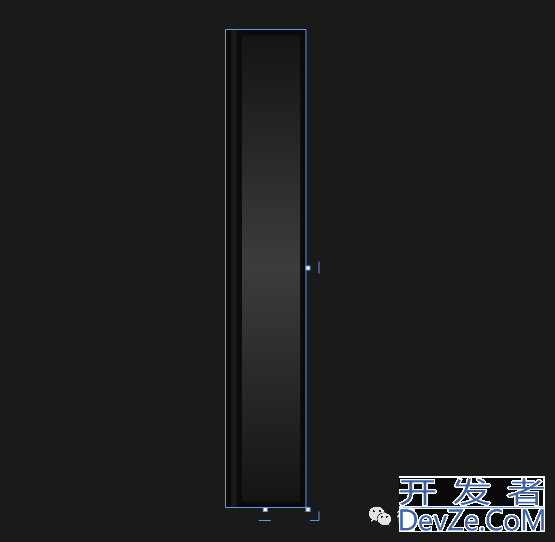基于WPF实现拟物音量控件
wpF 实现拟物音量控件
控件名:Wheel
作者:WPFDevelopersOrg - 俞宏伟
原文链接:https://github.com/WPFDevelopersOrg/SimulationControl
- 框架使用
.NET6; Visual Studio 2022;- 绘制使用了
Canvas作为容器控件,DrawingContext上绘制水平线。 - 当鼠标滚动滚轮时或按下鼠标向上向下拖动时计算角度偏移并更新图层。

实现代码
1)创建 Wheel.xaml 代码如下:
<UserControlx:Class="TopControl.Wheel" XMLns="http://schemas.microsoft.com/winfx/2006编程客栈/xaml/presentation" xmlns:x="http://schemas.microsoft.com/winfx/2006/xaml" xmlns:mc="http://schemas.openxmlformats.org/markup-compatibility/2006" xmlns:d="http://sche编程mas.microsoft.com/expression/blend/2008" xmlns:local="clr-namespace:TopControl" mc:Ignorable="d" Width="30"Height="180"> <Grid> <!--进度--> <Gridwidth="2"Background="#0a0a0a"Height="180"HorizontalAlignment="Left"VerticalAlignment="Bottom"/> <GridWidth="2"x:Name="Grid_Value"Height="0"HorizontalAlignment="Left"VerticalAlignment="Bottom"> <GridHeight="180"VerticalAlignment="Bottom"> <Grid.Background> <LinearGradientBrushStartPoint="0,0"EndPoint="0,1"> <GradientStopOffset="0"Color="#f0d967"/> <GradientStopOffset="1"Color="#33b08d"/> </LinearGradientBrush> </Grid.Background> </Grid> </Grid> <GridBackground="#0a0a0a"Width="26"HorizontalAlignment="Right"Height="180"Margin="2,0,0,0"/> <!--滚轮--> <Gridx:Name="WheelArea"Height="176"Width="22"HorizontalAlignment="Right"Margin="0,0,2,0" MouseDown="WheelArea_MouseDown"MouseMove="WheelArea_MouseMove"MouseUp="WheelArea_MouseUp"MouseWheel="WheelArea_MouseWheel"> <Grid.Background> <LinearGradientBrushStartPoint="0,0"EndPoint="0,1"> <GradientStopColor="#141414"Offset="0"/> <GradientStopColor="#3c3c3c"Offset="0.5"/> <GradientStopColor="#141414"Offset="1"/> </LinearGradientBrush> </Grid.Background> <Gridx:Name="LayerBox"IsHitTe开发者_JAVAstVisible="False"/> </Grid> </Grid> </UserControl>
2)创建 Wheel.xaml.cs 代码如下:
usingSystem.Windows;
usingSystem.Windows.Controls;
usingSystem.Windows.Input;
namespaceTopControl
{
publicpartialclassWheel:UserControl
{
publicWheel()
{
InitializeComponent();
Loaded+=Wheel_Loaded;
}
#region属性
publicintMinValue{get;set;}=-720;
publicintMaxValue{get;set;}=720;
publicintValue{get;set;}=-720;
#endregion
#region控件事件
privatevoidWheel_Loaded(objectsender,RoutedEventArgse)
{
InitLayer();
}
privatevoidWheelArea_MouseDown(objectsender,MouseButtonEventArgse)
{
if(e.ChangedButton==MouseButton.Left)
{
BeginDrag();
}
}
privatevoidWheelArea_MouseMove(objectsender,MouseEventArgse)
{
if(_dragMode)
{
Drag();
}
}
privatevoidWheelArea_MouseUp(objectsender,MouseButtonEventArgse)
{
if(e.ChangedButton==MouseButton.Left&&_dragMode)
{
EndDrag();
}
}
privatevoidWheelArea_MouseWheel(objectsender,MouseWheelEventArgse)
{
if(_dragMode)return;
intoffset=e.Delta/120;
if(offset<0&&Value>MinValue)
{
Value+=offset;
UpdateProgress();
_wheelLayer.AngleOffset-=offset*_wheelSpeed;
_wheelLayer.UpdateLayer();
}
elseif(offset>0&&Value<MaxValue)
{
Value+=offset;
UpdateProgress();
_wheelLayer.AngleOffset-=offset*_wheelSpeed;
_wheelLayer.UpdateLayer();
}
}
#endregion
#region鼠标操作
privatevoidBeginDrag()
{
_dragMode=true;
WheelArea.CaptureMouse();
_dragStart=Mouse.GetPosition(WheelArea);
_angleStart=_wheelLayer.AngleOffset;
_valueStart=Value;
_offsetDown=Value-MinValue;
_offsetUp=Value-MaxValue;
}
privatevoidDrag()
{
doubleoffset_y=Mouse.GetPosition(WheelArea).Y-_dragStart.Y;
if(offset_y<_offsetUp)offset_y=_offsetUp;
elseif(offset_y>_offsetDown)offset_y=_offsetDown;
doubleoffset_angle=offset_y*_wheelSpeed;
Value=_valueStart-(int)offset_y;
_wheelLayer.AngleOffset=_angleStart+offset_angle;
UpdateProgress();
_wheelLayer.UpdateLayer();
}
privatevoidEndDrag()
{
_dragMode=false;
WheelArea.ReleaseMouseCapture();
}
#endregion
#region私有方法
///<summary>
///初始化图层
///</summary>
privatevoidInitLayer()
{
_wheelLayer.Width=LayerBox.ActualWidth;
_wheelLayer.Height=LayerBox.ActualHeight;
LayerBox.Children.Add(_wheelLayer);
_wheelLayer.Init();
_wheelLayer.UpdateLayer();
}
///<summary>
///更新进度
///</summary>
privatevoidUpdateProgress()
{
Grid_Value.Height=(double)(Value-MinValue)/(MaxValue-MinValue)*180;
}
#endregion
#region字段
privatereadonlyWheelLayer_wheelLayer=newWheelLayer();
privatePoint_dragStart=newPoint();
privatedouble_angleStart=0;
privateint_valueStart=0;
privatebool_dragMode=false;
///<summary>滚轮速度</summary>
privatereadonlydouble_wheelSpeed=0.7;
///<summary>最大向上偏移</summary>
privatedouble_offsetUp;
///<summary>最大向下偏移</summary>
privatedouble_offsetDown;
#endregion
}
}
3)创建 WheelLayer.cs 代码如下:
usingMathUtil;
usingSystem;
usingSystem.Collections.Generic;
usingSystem.Runtime.CompilerServices;
usingSystem.Windows;
usingSystem.Windows.Media;
usingWpfUtil;
namespaceTopControl
{
publicclassWheelLayer:SingleLayer
{
#region属性
///<summary>槽高度:180px -上下边框(4px)</summary>
publicintGrooveHeight{get;set;}=176;
///&androidlt;summary>角度:圆弧切线与槽边的夹角</summary>
publicintAngle{get;set;}=90;
///<summary>刻度线数量</summary>
publicintLineCount{get;set;}=90;
///<summary>角度偏移</summary>
publicdoubleAngleOffset{get;set;}=0;
#endregion
#region公开方法
publicoverridevoidInit()
{
//起点、终点、中点
Point2DstartPoint=newPoint2D(0,0);
Point2DendPoint=newPoint2D(GrooveHeight,0);
Point2DcenterPoint=startPoint.CenterWith(endPoint);
//向量:中点->起点
Vector2centerToStart=newVector2(centerPoint,startPoint);
centerToStart.Rotate(-90);
//向量:终点->中点
Vector2endToCenter=newVector2(endPoint,centerPoint);
endToCenter.Rotate(-90+Angle);
//圆心
_circleCenter=centerToStart.IntersectionWith(endToCenter);
//向量:圆心->起点
Vector2vector=newVectorandroid2(_circleCenter,startPoint);
_radius=vector.Distance;
_angleperline=360.0/LineCount;
}
protectedoverridevoidOnUpdate()
{
//最高点
Point2Dtop=newPoint2D(_circleCenter.X,_circleCenter.Y-_radius);
//向量:圆心->最高点
Vector2vector=newVector2(_circleCenter,top);
doublemax=Math.Abs(vector.Target.Y);
//偏移角度
vector.Rotate(AngleOffset);
//开始旋转计算刻度位置
List<Point2D>pointList=newList<Point2D>();
for(intcounter=0;counter<LineCount;counter++)
{
if(vector.Target.Y<0)pointList.Add(vector.Target);
vector.Rotate(-_anglePerLine);
}
//绘制刻度线
foreach(variteminpointList)
DrawHorizontalLine(item.X,Math.Abs(item.Y)/max);
}
#endregion
#region私有方法
///<summary>
///绘制水平线
///</summary>
[MethodImpl(MethodImplOptions.AggressiveInlining)]
privatevoidDrawHorizontalLine(doubley,doubleopacity)
{
Penpen=newPen(newSolidColorBrush(Color.FromArgb((byte)(opacity*255),32,32,32)),1);
Penpen2=newPen(newSolidColorBrush(Color.FromArgb((byte)(opacity*255),64,64,64)),1);
_dc.DrawLine(pen,newPoint(2,y-0.5),newPoint(Width-2,y-0.5));
_dc.DrawLine(pen2,newPoint(2,y+0.5),newPoint(Width-2,y+0.5));
}
#endregion
#region字段
///<summary>圆心</summary>
privatePoint2D_circleCenter=newPoint2D(0,0);
///<summary>半径</summary>
privatedouble_radius=0;
///<summary>刻度线之间的夹角</summary>
privatedouble_anglePerLine=0;
#endregion
}
}
4)创建 WheelExample.xaml 代码如下:
<wd:Windowx:Class="TopControl.MainWindow" xmlns="http://schemas.microsoft.com/winfx/2006/xaml/presentation" xmlns:x="http://schemas.microsoft.com/winfx/2006/xaml" xmlns:d="http://schemas.microsoft.cojsm/expression/blend/2008" xmlns:mc="http://schemas.openxmlformats.org/markup-compatibility/2006" xmlns:local="clr-namespace:TopControl" xmlns:wd="https://github.com/WPFDevelopersOrg/WPFDevelopers" mc:Ignorable="d"Background="#1e1e1e" Title="https://github.com/WPFDevelopersOrg/SimulationControl-俞宏伟"Height="450"Width="800"> <Grid> <local:WheelHorizontalAlignment="Left"VerticalAlignment="Top"Margin="50"/> </Grid> </wd:Window>
效果图

以上就是基于WPF实现拟物音量控件的详细内容,更多关于WPF拟物音量控件的资料请关注我们其它相关文章!





 加载中,请稍侯......
加载中,请稍侯......
精彩评论